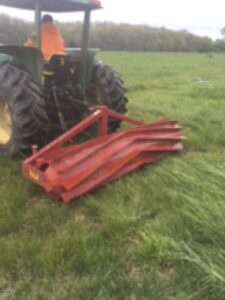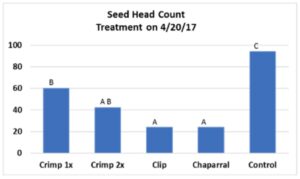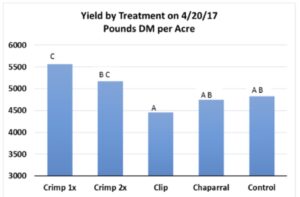Final report for ONC17-028
Project Information
In Missouri and the other central US states of the “Fescue Belt”, grazing management of Tall Fescue pastures includes management of fescue seed heads. Endophyte infected tall fescue has the highest concentration of the toxic alkaloids in the seed. Removing these heads reduces the negative animal health effects of grazing infected fescue. For many producers, this involves “clipping” pastures with rotary mowers. In addition to removing seed heads, the cutting/damage to upper canopy foliage stimulates additional vegetative growth for increased carrying capacity.
This study evaluated the ability of a “roller-crimper”, normally used to mechanically terminate cover crops, to serve as a lower cost-of-operation alternative to rotary mowing for seed head control.
Treatments evaluated were:
1) Rotary Mowing, Clipping
2) Chemical Spray, Chaparral©herbicide
3) Single Pass w/ Roller/Crimper, Crimp 1X
4) Double Pass w/ Roller Crimper, Crimp 2X
5) No applied Treatment, Control
Seed head counts and dry matter yield data were collected at the end of the spring growing season.
Quantify through forage sampling:
- Degree of seed head control with rotary mowing versus crimp/rolling.
- Pasture yields by treatment.
- Nutritional value of sward by treatment.
- Per acre cost of control by treatment.
Cooperators
Research
Since fescue seed heads have the highest concentration of the alkaloids impacting animal health, the treatments being evaluated are all part of a seed head reduction strategy.
The treatments are:
1) Rotary mowing (clipping) is the predominant strategy for the 3 farms participating in this study. The machinery used in clipping is expensive to operate with high-horsepower requirements.
2) Single-pass with the roller-crimper has a lower power requirement than mowing (smaller tractor needed), and has an increased operating speed for the potential to cover more acres per day.
3) Double-pass with the roller-crimper to observe any effectiveness gained over a single pass (the second pass of the double was made immediately following the first).
4) Chaparral herbicide at the label recommended 2 oz/ac rate.
5) Control with no treatment for a baseline.
The link above shows the plot layout with 5 treatments, replicated 4 times and randomized.
One-half meter, square quadrants were tossed at random, in three locations for each treatment. Seed heads were counted and totaled for the three quadrant locations. All forage with-in the quadrant was removed at the soil level. Forage was oven-dried and yield calculations made on a dry-matter basis.
The seed head data shows that:
All treatments yielded a significant reduction in seed head counts, as compared to Control.(Fig. 1)
Clippingand Chaparral were similar with 75% reduction in seed heads.
Crimp 1X reduced seed heads by 36%.
Treatment effect on dry matter yield, as compared to Control. (Fig. 2)
Clipping and Chaparral did reduce yield, but it was not statistically significant.
The Roller/Crimper increased yield, with Crimp 1X being statistically significant with a 13% increase.
Economic Summary for Dry Matter Fescue Yield
One-pass with a Roller-Crimper, Crimp 1X
5,567 # dry matter/acre
Two-passes with a Roller-Crimper, Crimp 2X
5,175 # dry matter/acre
Chaparral© herbicide application, Chaparral©
4,748 # dry matter/acre
Rotary Mower Clipping, Clip
4,458 # dry matter/acre
Control treatment with no action taken, Control
4,829 # dry matter/acre
The costs of each treatment is based upon the 2016 Missouri Custom Rate Guidefor machinery usage, plus purchased inputs such as the chemical herbicide. Operation of the Roller/Crimper was comparable to “raking hay” and that cost from the Custom Rate Guidewas used.
The change in forage quantity was valued at $0.02/lb of dry matter.
Value of “Good” pasture, $40.74/acre, 2018 Cash Rental Rates in Missouri.
|
Treatment |
DM Yield pounds |
DM Value Total $ |
Cost/Acre Treatment |
Yield Increase pounds |
Cost/Ton Additional Forage |
Cost/Ton Total Forage |
|
Crimp 1x |
5,567 |
111.34 |
6.65 |
738 |
18.02 |
17.03 |
|
Crimp 2x |
5,175 |
103.50 |
13.30 |
346 |
76.88 |
20.89 |
|
Chaparral© |
4,748 |
94.96 |
20.02 |
- 81 |
|
25.59 |
|
Rotary Clip |
4,458 |
89.16 |
15.29 |
- 371 |
|
25.14 |
|
Control |
4,829 |
96.58 |
0 |
0 |
|
16.87 |
Conclusion:
The narrow window of time when fescue is at the proper stage of growth for effective seed head control, combined with the acres involved in farm-scale pasture management, requires a rotary mower and tractor larger than is found on a typical Missouri cattle farm. The faster ground speed and lower horsepower requirements of the necessary roller/crimper, is compatible with existing tractors used for haying operations. This allows for the demonstrated reduction in toxic seed head amounts and the potential for increased forage growth, with the smaller capital investment of using a farm’s existing tractor.
Educational & Outreach Activities
Participation summary:
The 11 consults have been with individual farm operations who wanted to know what we were finding in our study. Word-of-mouth spread about the project and producers sought the information. These 11 discussions reached 14 producers.
There have been 4 on-farm demonstrations of the equipment that reached 5 farmers and 9 ag professionals.
There have been 3 formal presentations of the preliminary data to farmer groups. These reached 90 producers and 3 ag professionals.
There has been 2 field days of the plots that reached 103 producers and 6 ag professionals.
Learning Outcomes
Fescue plant seeds having the highest concentration of anti-quality compounds associated with grazing animal impact.
The need to limit availability of fescue seed heads in a grazing paddock.
Three methods of seed head reduction; 1)chemical herbicide, 2)rotary mowing, 3)roller/crimper
Timeliness requirements relevant to all reduction techniques. Plants must be treated prior to "boot" growth stage, and it is a narrow window of time.
Realization of need to act. Producers elevated the importance for seed head control on their operations, and understand that it can be a combination of all 3 techniques.
Project Outcomes
Increased awareness of Fescue Toxicosis. Even with the positive attributes for Tall Fescue, (stand persistence, drought tolerance, tolerance of insect pressure, over-grazing) management of the effects of toxicosis is critical to the survival of a grazing livestock operation.
There are 17 million acres of Tall Fescue in Missouri and over 40 million acres in the US. Estimates from 1990 is a $609 million a year in losses to the US beef cattle industry due to Fescue Toxicosis.
Increased understanding of the value of seed head control in reducing the negative effects of grazing infected Tall Fescue. As producers adopt seed head control strategies on part of Missouri’s 17 million forage acres, any reductions in costs per acre has a large multiplier when thought of in terms of state-wide effect.
This project demonstrated the viability of the roller/crimper being part of a seed head control strategy. The crimper can take the place of chemical applications and/or the higher energy consuming process of rotary mowing.
In addition to the 212 producers reached through field days and demonstrations, 18 ag professionals/educators were also reached. Through follow-up conversations and idea exchanges with these educators, project impact has been leveraged beyond the producers directly related to this project.


